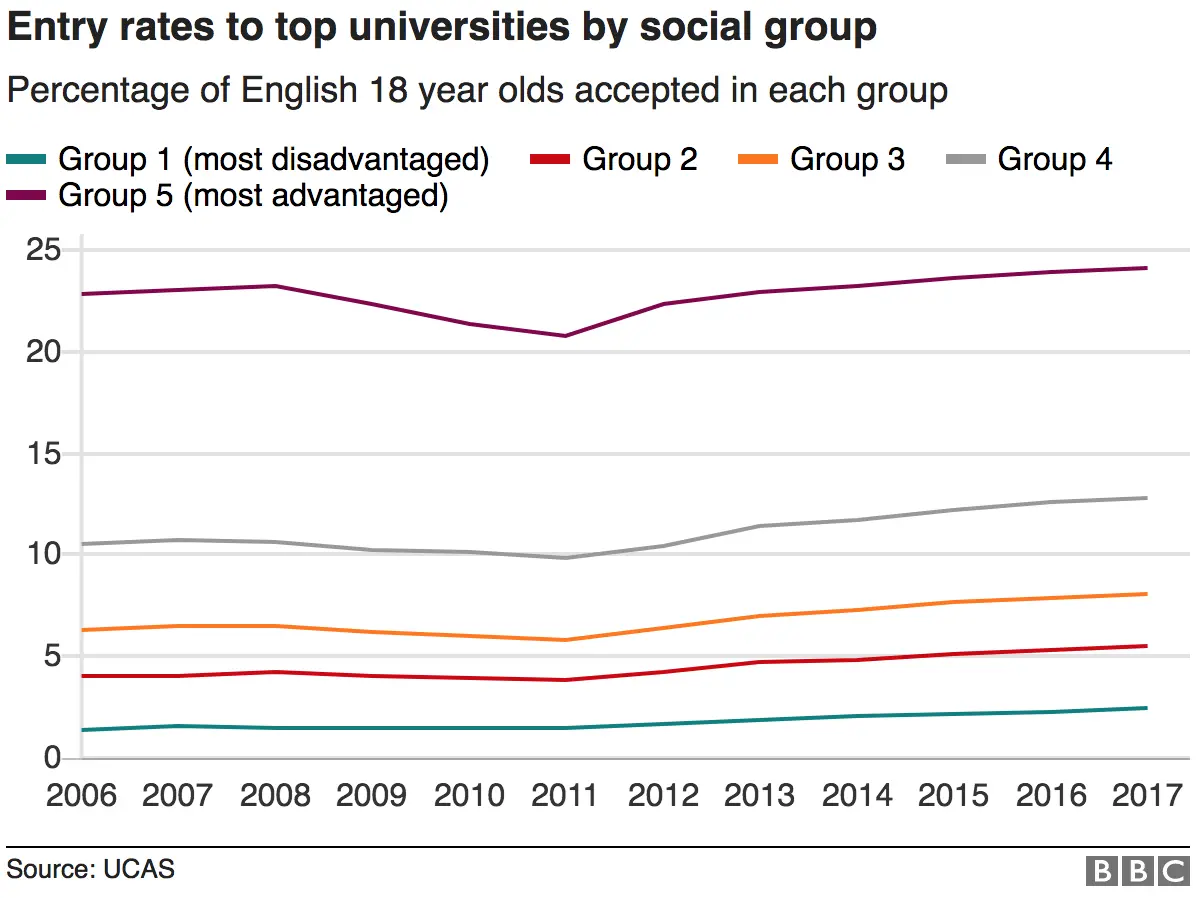Wealthy students tighten grip on university places
 Getty Images
Getty ImagesThe most advantaged teens have tightened their grip on university places, pulling further ahead of the least advantaged, Ucas data shows.
Although more poorer students won places at university this year, wealthy students increased at a higher rate.
Universities Minister Jo Johnson said he was reforming the sector to encourage equality of opportunity.
The data also shows the number of unconditional offers made to students jumped 40% last year to 51,615.
These are offers made to students on the basis of their predicted grades rather than their actual results.
Although at least one unconditional offer was made to 17.5% of students it is important to remember that students generally make five choices and often have multiple offers from which to chose.
This year, unconditional offers accounted for less than 5% of offers made by the majority of the largest 140 higher education providers.
Equality measure
Assessing the year-on-year data, the University and College Admissions Service said there had been no progress in equal representation since 2014.
Successive ministers have required universities to do more to increase access for disadvantaged groups.
And Prime Minister Theresa May pledged to put social mobility at the heart of her policies
Ucas is using a new measure of equality that combines social background, ethnicity and gender to examine how well universities are opening their doors to all sections of society.
Statisticians feel it sheds more light on the issue of equality of access because it looks at the interplay of a number of factors.
Details of this backwards step on social mobility come at a time when the chances of getting a place at university have never been higher.
In 2017, a third of 18-year-olds were accepted on to higher education courses in England.
But a detailed look at who these teenagers are shows the most advantaged group increased their entry rate by 1.8% to 53.1% in 2017.

This means over half of 18-year-olds in this top social group got places at university.
Meanwhile, 13.8% of the most disadvantaged group netted places on courses, an increase of 1.2%.
The statistics also show teenagers from the most advantaged group are still nearly 10 times more likely to attend the most competitive universities.

However, the least advantaged students have made some headway, increasing their entry rates to these top institutions by 7.4%.
Clare Marchant, chief executive of Ucas, said: "Although our analysis shows that a record number of disadvantaged young people have entered higher education this year - with the greatest increase at higher-tariff providers - gaps in participation remain wide."
The Ucas data also again shows that white pupils are less likely to go to university than any other ethnic group.
'More to do'
Universities Minister Jo Johnson said he was encouraged by the record entry rates for young people going to university, including those from disadvantaged backgrounds.
"Today's figures show that 18-year-olds from disadvantaged areas are now 50% more likely to go university in 2017 than in 2009.
"However, we recognise that there is more to do.
"That's why we have introduced sweeping reforms, including the new Office for Students, to ensure equality of opportunity."
Geoff Barton, head of the Association of School and College Leaders, said: "Schools and colleges across the country are straining every sinew to improve the opportunities for disadvantaged pupils, and indeed all their young people. Significant challenges remain, however.
"In many communities, the impact of unemployment, insecure and low-paid work, and poor quality housing has had a devastating impact on the hopes and aspirations of families.
"In areas where traditional industries have collapsed, many white British families have been badly affected, and it is therefore not surprising that white pupils are proportionally less likely to go to university than other ethnic groups."
Prof Les Ebdon, director of Fair Access to Higher Education, was encouraged by the increase in disadvantaged students at top universities, but said they were still 5.5 times less likely to attend these institutions than their advantaged peers.
"As a result, people with the potential to excel are missing out on opportunities. This is an unforgivable waste of talent, and universities must continue to press for transformational progress."
